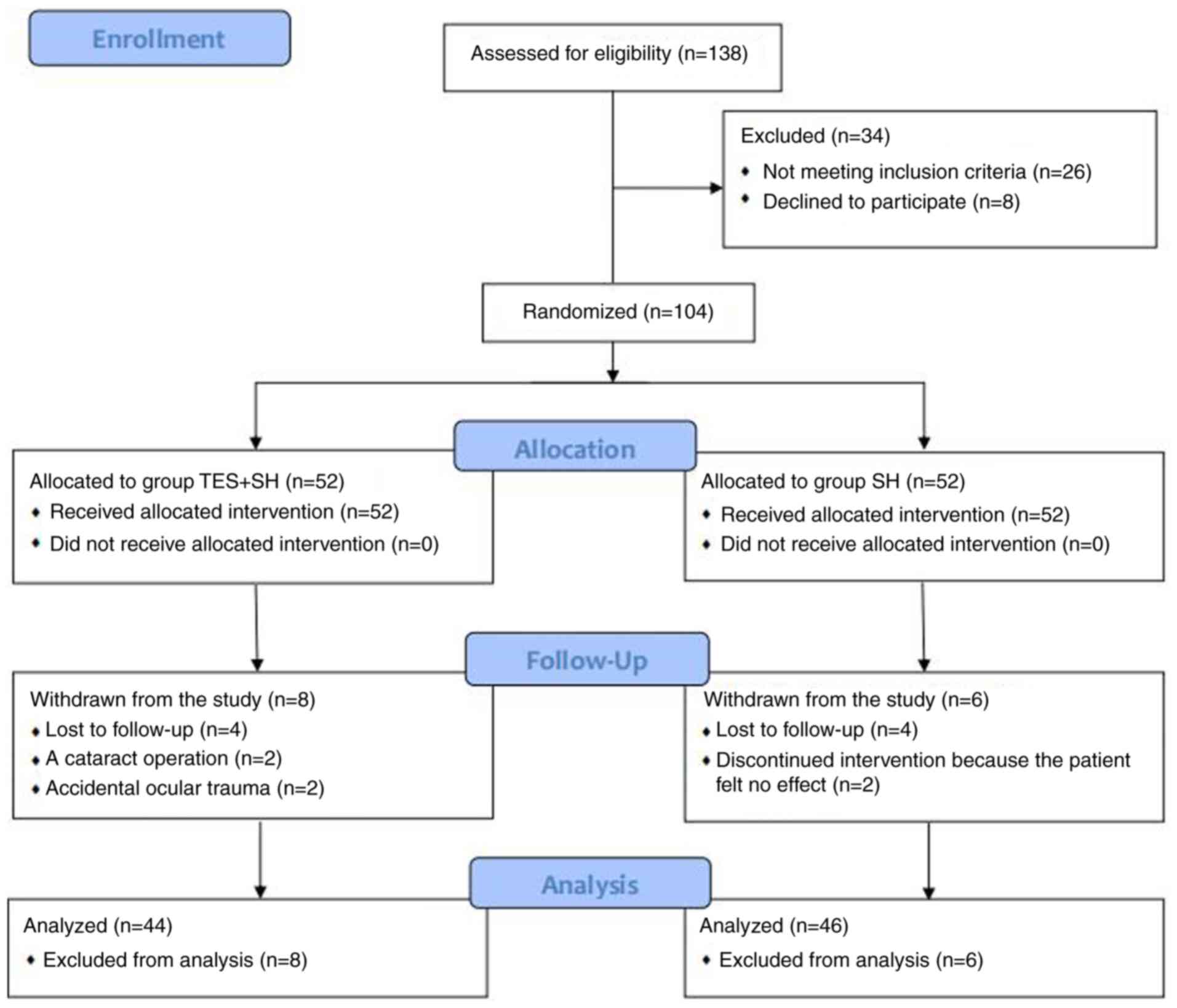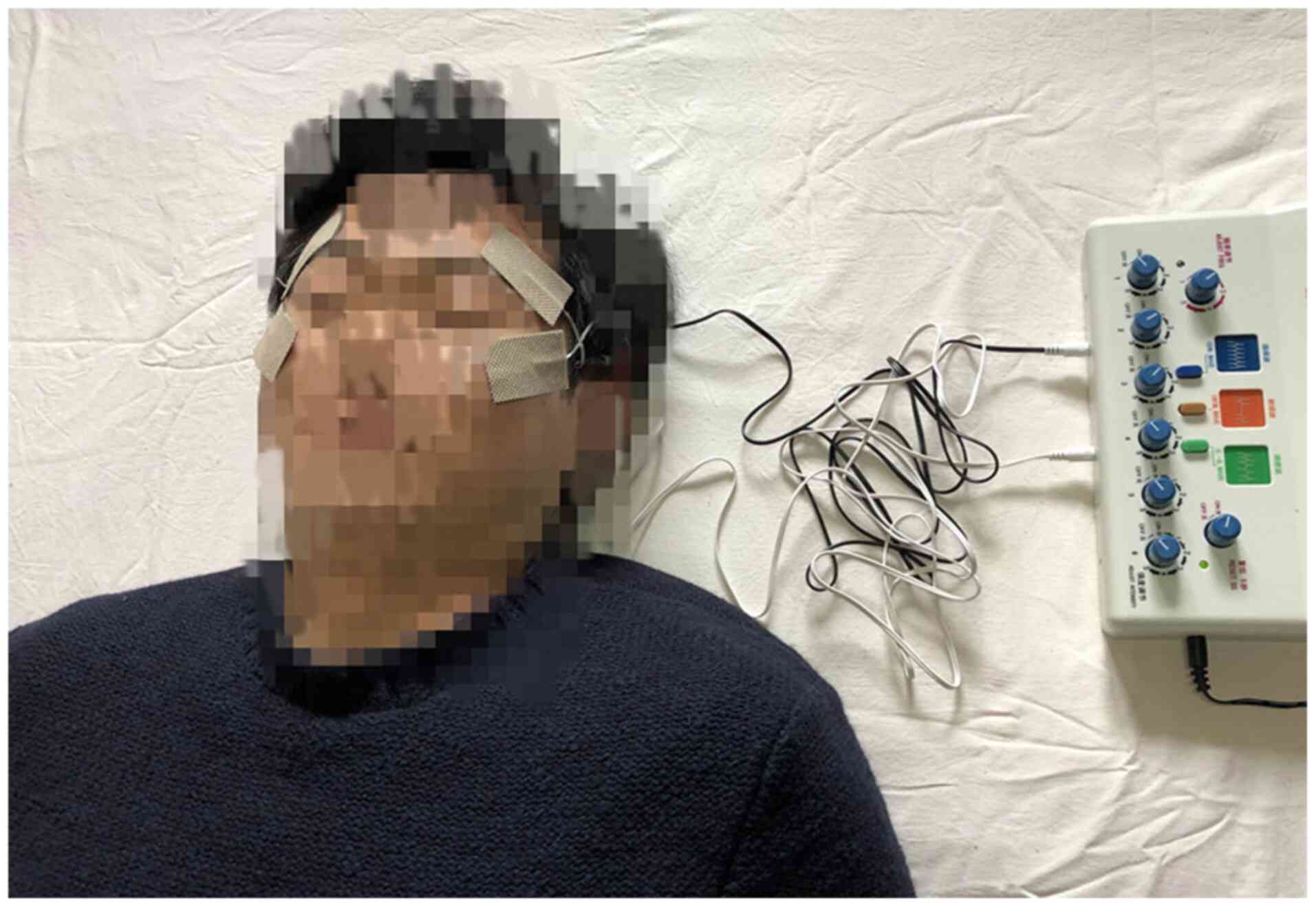|
1
|
Craig JP, Nichols KK, Akpek EK, Caffery B,
Dua HS, Joo CK, Liu Z, Nelson JD, Nichols JJ, Tsubota K and
Stapleton F: TFOS DEWS II defnition and classifcation report. Ocul
Surf. 15:276–283. 2017.PubMed/NCBI View Article : Google Scholar
|
|
2
|
Merayo-Lloves J, Sanchez-Avila RM, Riestra
AC, Anitua E, Begoña L, Orive G and Fernandez-Vega L: Safety and
efficacy of autologous plasma rich in growth factors eye drops for
the treatment of evaporative dry eye. Ophthalmic Res. 56:68–73.
2016.PubMed/NCBI View Article : Google Scholar
|
|
3
|
García-Conca V, Abad-Collado M,
Hueso-Abancens JR, Mengual-Verdú E, Piñero DP, Aguirre-Balsalobre F
and Molina JC: Efficacy and safety of treatment of hyposecretory
dry eye with platelet-rich plasma. Acta Ophthalmol. 97:e170–e178.
2019.PubMed/NCBI View Article : Google Scholar
|
|
4
|
Friedman NJ, Butron K, Robledo N, Loudin
J, Baba SN and Chayet A: A nonrandomized, open-label study to
evaluate the effect of nasal stimulation on tear production in
subjects with dry eye disease. Clin Ophthalmol. 10:795–804.
2016.PubMed/NCBI View Article : Google Scholar
|
|
5
|
Kossler AL, Wang J, Feuer W and Tse DT:
Neurostimulation of the lacrimal nerve for enhanced tear
production. Ophthal Plast Reconstr Surg. 31:145–151.
2015.PubMed/NCBI View Article : Google Scholar
|
|
6
|
Rosenthal P and Borsook D: The corneal
pain system Part I: The missing piece of the dry eye puzzle. Ocul
Surf. 10:2–14. 2012.PubMed/NCBI View Article : Google Scholar
|
|
7
|
Sivanesan E, Levitt RC, Sarantopoulos CD,
Patin D and Galor A: Noninvasive electrical stimulation for the
treatment of chronic ocular pain and photophobia. Neuromodulation.
21:727–734. 2018.PubMed/NCBI View Article : Google Scholar
|
|
8
|
Gofeld M: New horizons in neuromodulation.
Curr Pain Headache Rep. 18(397)2014.PubMed/NCBI View Article : Google Scholar
|
|
9
|
Goroszeniuk T and Pang D: Peripheral
neuromodulation: A review. Curr Pain Headache Rep.
18(412)2014.PubMed/NCBI View Article : Google Scholar
|
|
10
|
Kacker R, Lay A and Das A: Electrical and
mechanical offce-based neuromodulation. Urol Clin North Am.
40:581–589. 2013.PubMed/NCBI View Article : Google Scholar
|
|
11
|
Luan S, Williams I, Nikolic K and
Constandinou TG: Neuromodulation: Present and emerging methods.
Front Neuroeng. 7(27)2014.PubMed/NCBI View Article : Google Scholar
|
|
12
|
Park C, Choi JB, Lee YS, Chang HS, Shin
CS, Kim S and Han DW: The effect of intra-operative transcutaneous
electrical nerve stimulation on posterior neck pain following
thyroidectomy. Anaesthesia. 70:434–439. 2015.PubMed/NCBI View Article : Google Scholar
|
|
13
|
Santana LS, Gallo RB, Ferreira CH, Duarte
G, Quintana SM and Marcolin AC: Transcutaneous electrical nerve
stimulation (TENS) reduces pain and postpones the need for
pharmacological analgesia during labour: A randomised trial. J
Physiother. 62:29–34. 2016.PubMed/NCBI View Article : Google Scholar
|
|
14
|
Engen DJ, Carns PE, Allen MS, Bauer BA,
Loehrer LL, Cha SS, Chartrand CM, Eggler EJ, Cutshall SM and
Wahner-Roedler DL: Evaluating efficacy and feasibility of
transcutaneous electrical nerve stimulation for postoperative pain
after video-assisted thoracoscopic surgery: A randomized pilot
trial. Complement Ther Clin Pract. 23:141–148. 2016.PubMed/NCBI View Article : Google Scholar
|
|
15
|
Rakel BA, Zimmerman MB, Geasland K, Embree
J, Clark CR, Noiseux NO, Callaghan JJ, Herr K, Walsh D and Sluka
KA: Transcutaneous electrical nerve stimulation for the control of
pain during rehabilitation after total knee arthroplasty: A
randomized, blinded, placebo-controlled trial. Pain. 155:2599–2611.
2014.PubMed/NCBI View Article : Google Scholar
|
|
16
|
Whitacre MM: The effect of transcutaneous
electrical nerve stimulation on ocular pain. Ophthalmic Surg.
22:462–466. 1991.PubMed/NCBI
|
|
17
|
Ghaffariyeh A, Peyman A, Puyan S,
Honarpisheh N, Bagheri B and Peyman M: Evaluation of transcutaneous
electrical simulation to improve recovery from corneal hypoesthesia
after LASIK. Graefes Arch Clin Exp Ophthalmol. 247:1133–1138.
2009.PubMed/NCBI View Article : Google Scholar
|
|
18
|
Pedrotti E, Bosello F, Fasolo A, Frigo AC,
Marchesoni I, Ruggeri A and Marchini G: Transcutaneous periorbital
electrical stimulation in the treatment of dry eye. Br J
Ophthalmol. 101:814–819. 2017.PubMed/NCBI View Article : Google Scholar
|
|
19
|
Pall ML: Electromagnetic fields act via
activation of voltage-gated calcium channels to produce beneficial
or adverse effects. J Cell Mol Med. 17:958–965. 2013.PubMed/NCBI View Article : Google Scholar
|
|
20
|
Amparo F, Schaumberg DA and Dana R:
Comparison of two questionnaires for dry eye symptom assessment:
The ocular surface disease index and the symptom assessment in dry
eye. Ophthalmology. 122:1498–1503. 2015.PubMed/NCBI View Article : Google Scholar
|
|
21
|
Lemp MA: Report of the national eye
institute/industry workshop on clinical trials in dry eyes. CLAO J.
21:221–232. 1995.PubMed/NCBI
|
|
22
|
Sook Chun Y and Park IK: Reliability of 4
clinical grading systems for corneal staining. Am J Ophthalmol.
157:1097–1102. 2014.PubMed/NCBI View Article : Google Scholar
|
|
23
|
Cohn GS, Corbett D, Tenen A, Coroneo M,
McAlister J, Craig JP, Gray T, Kent D, Murray N, Petsoglou C, et
al: Randomized, controlled, double-masked, multicenter, pilot study
evaluating safety and effificacy of intranasal neurostimulation for
dry eye disease. Invest Ophthalmol Vis Sci. 60:147–153.
2019.PubMed/NCBI View Article : Google Scholar
|
|
24
|
Gumus K and Pflugfelder SC: Intranasal
tear neurostimulation: an emerging concept in the treatment of dry
eye. Int Ophthalmol Clin. 57:101–108. 2017.PubMed/NCBI View Article : Google Scholar
|
|
25
|
Pattar GR, Jerkins G, Evans DG, Torkildsen
GL, Ousle GW, Hollander DA, Holdbrook M and Senchyna M: Symptom
improvement in dry eye subjects following intranasal tear
neurostimulation: Results of two studies utilizing a controlled
adverse environment. Ocul Surf. 18:249–257. 2020.PubMed/NCBI View Article : Google Scholar
|
|
26
|
Farhangi M, Cheng AM, Baksh B,
Sarantopoulos CD, Felix ER, Levitt RC and Galor A: Effect of
non-invasive intranasal neurostimulation on tear volume, dryness
and ocular pain. Br J Ophthalmol. 104:1310–1316. 2020.PubMed/NCBI View Article : Google Scholar
|
|
27
|
Ozcura F, Aydin S and Helvaci MR: Ocular
surface disease index for the diagnosis of dry eye syndrome. Ocul
Immunol Inflamm. 15:389–393. 2007.PubMed/NCBI View Article : Google Scholar
|
|
28
|
Schiffman RM, Christianson MD, Jacobsen G,
Hirsch JD and Reis BL: Reliability and validity of the ocular
surface disease index. Arch Ophthalmol. 118:615–621.
2000.PubMed/NCBI View Article : Google Scholar
|
|
29
|
Chiou YF, Yeh ML and Wang YJ:
Transcutaneous electrical nerve stimulation on acupuncture points
improves myofascial pain, moods, and sleep quality. Rehabil Nurs.
45:225–233. 2020.PubMed/NCBI View Article : Google Scholar
|
|
30
|
Galor A, Levitt RC, Felix ER, Martin ER
and Sarantopoulos CD: Neuropathic ocular pain: An important yet
underevaluated feature of dry eye. Eye (Lond). 29:301–312.
2015.PubMed/NCBI View Article : Google Scholar
|
|
31
|
Ainsworth L, Budelier K, Clinesmith M,
Fiedler A, Landstrom R, Leeper BJ, Moeller L, Mutch S, O'Dell K,
Ross J, et al: Transcutaneous electrical nerve stimulation (TENS)
reduces chronic hyperalgesia induced by muscle inflammation. Pain.
120:182–187. 2006.PubMed/NCBI View Article : Google Scholar
|
|
32
|
Grover CA, McKernan MP and Close RJH:
Transcutaneous Electrical Nerve Stimulation (TENS) in the emergency
department for painrelief: A preliminary study of feasibility and
efficacy. West J Emerg Med. 19:872–876. 2018.PubMed/NCBI View Article : Google Scholar
|
|
33
|
Gozani SN: Fixed site high-frequency
transcutaneous electrical nerve stimulation for treatment of
chronic low back and lower extremity pain. J Pain Res. 9:469–479.
2016.PubMed/NCBI View Article : Google Scholar
|
|
34
|
Zhu Y, Feng Y and Peng L: Effect of
transcutaneous electrical nerve stimulation for pain control after
total knee arthroplasty: A systematic review and meta analysis. J
Rehabil Med. 49:700–704. 2017.PubMed/NCBI View Article : Google Scholar
|
|
35
|
Garrison DW and Foreman RD: Decreased
activity of spontaneous and noxiously evoked dorsal horn cells
during transcutaneous electrical nerve stimulation (TENS). Pain.
58:309–315. 1994.PubMed/NCBI View Article : Google Scholar
|
|
36
|
Dieckmann G, Fregni F and Hamrah P:
Neurostimulation in dry eye disease-past, present, and future. Ocul
Surf. 17:20–27. 2019.PubMed/NCBI View Article : Google Scholar
|
















